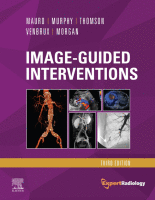Physical Address
304 North Cardinal St.
Dorchester Center, MA 02124

This chapter specifically describes the management of aortic aneurysms that involve both the thoracic and abdominal segments of the aorta and its associated visceral branches. The reader should note that extensive aortic pathologies commonly require solutions incorporating combinations of open…

Continuous development in endovascular treatment of ab-dominal and thoracic aortic aneurysms, together with growing experience and encouraging results, have paved the way for a new generation of stent-grafts, to treat those previously unsuitable for conventional endovascular repair. One such advancement…

Clinical Relevance Abdominal aortic aneurysms (AAAs) occur in approximately 5% to 10% of the male population older than 65 years, and the incidence increases with advancing age. The risk of rupture is very low for aneurysms less than 5 cm…

Abdominal Aorta The abdominal aorta continues from the thoracic aorta as it passes posterior to the median arcuate ligament and between the crura of the diaphragm (aortic hiatus), in front of the body of the T12 vertebra and then descends…

Vascular anomalies are often poorly managed for a number of reasons: they are uncommon (other than the true infantile hemangioma), their mode of presentation is extremely variable, their classification has been very confusing and is still poorly understood by the…

The goal of sclerotherapy is to obliterate abnormal channels by damaging the endothelium, thereby resulting in subsequent inflammation and fibrosis. Venous malformations (VMs) are caused by abnormal development of the vein wall, with thinning and asymmetric disruption of the smooth…

Vascular anomalies are a complex group of developmental abnormalities due to inborn errors of vasculogenesis or angiogenesis that present significant challenges in diagnosis and management. Because of the rarity and diverse presentation of these anomalies, patients are often seen by…

In most countries, critical limb ischemia (CLI) has an incidence estimated to be 50 to 100 per 100,000 every year. CLI has a high mortality and morbidity rate and consumes important health and social care resources. , Aging of the…

Acknowledgment The authors express their gratitude to Dr. Mahmood Razavi for his insight and support in writing this chapter. Femoropopliteal occlusive disease is present in a significant proportion of older patients, with about 20% of men and 17% of women…

Epidemiology Aortoiliac occlusive disease (AIOD) refers to stenotic or occlusive disease of the infrarenal aorta and iliac arteries, and is a significant cause of peripheral arterial disease (PAD). Epidemiologic studies reporting on PAD include both AIOD and infrainguinal arterial disease,…